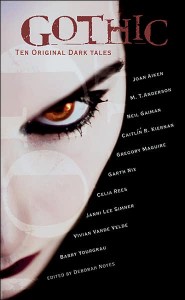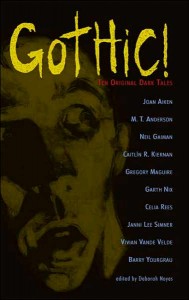
 Much like the Addams Family, this all-new collection of stories is creepy, spooky, and just a little bit odd, invoking the very best of the gothic spirit, in the tradition of Mary Shelley and Edgar Allan Poe. Part horror, part psychological thriller, these stories play both on supernatural fears and all too human terrors.
Much like the Addams Family, this all-new collection of stories is creepy, spooky, and just a little bit odd, invoking the very best of the gothic spirit, in the tradition of Mary Shelley and Edgar Allan Poe. Part horror, part psychological thriller, these stories play both on supernatural fears and all too human terrors.
M. T. Anderson’s “Dead Watch” is inspired by an old Roman folk tale, but also has its roots in some of the more eerie European fairy tales. When a traveler in need of some extra money agrees to watch over a recently deceased man’s body for the night, so as to protect it from the predations of witches and other nocturnal nasties, he soon finds that he’s in for much more then he bargained. The ending is skin-crawling and unexpected, sure to leave you jumping the next time a branch scratches against the window at night. Set in the same world as Anderson’s equally chilling Thirsty, “Dead Watch” looks at a modern society haunted by the creatures of the night, usually for the worse.
Barry Yourgrau produces a major twist on an old theme in “Have No Fear, Crumpot Is Here!” Basically, Walter Mitty meets Dennis the Menace with a vampiric twist, when a young man with too many dreams and not enough responsibility ends up babysitting a real hellion of a child, a summer job which can only end in tears. As the protagonist might label it, this one is “Crumpot and the Underage Vampire of Doom.” It’s pure comedy, but the sort that leaves you chuckling uneasily, and checking the time to see how long until nightfall. Just in case.
Then there’s Gregory McGuire’s “The Prank,” in which a young woman sent to live with her aunt as an alternate to a home for trouble teens, after a social mishap, discovers some bizarre secrets regarding her family. Just who is that in the attic, and why does she look so young and beautiful despite her purported age?
“Endings,” by Garth Nix, is the tale of a vampire who’s existed far beyond his prime, whose legend is forever intertwined with Sorrow and Joy, only one of which can free him from the curse of immortality.
Neil Gaiman deconstructs the genre, then reworks it, in his preposterously-long-titled offering, “Forbidden Brides of the Faceless Slaves in the Nameless House of the Night of Dread Desire.” It’s both a story, and a story about someone writing a story, and to describe it further would rob it of its power. Gaiman, ever the master of the dark fantasy and twisted folktale, is in his element with this self-aware, wryly Gothic tale.
Stories by Joan Aiken, Caitlin R. Kiernan, Celia Rees, Janni Lee Simner and Vivan Vande Velde finish off this delightfully dark collection. Though aimed at young adult readers, with many of the protagonists themselves teenagers or younger, this is an anthology which older readers will enjoy just as much, though I wouldn’t read it before bedtime. Sometimes, it’s a little too effective at evoking those hidden feelings of dread and unease.
